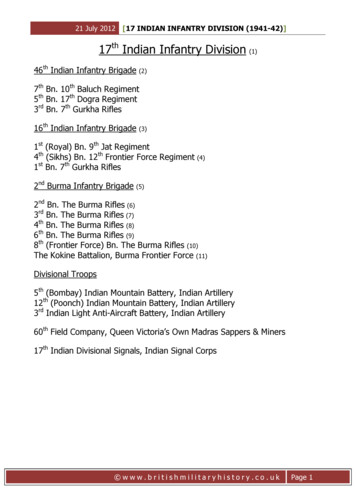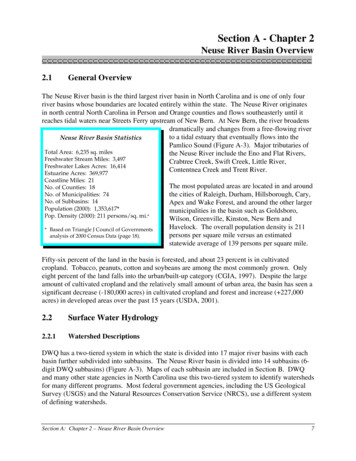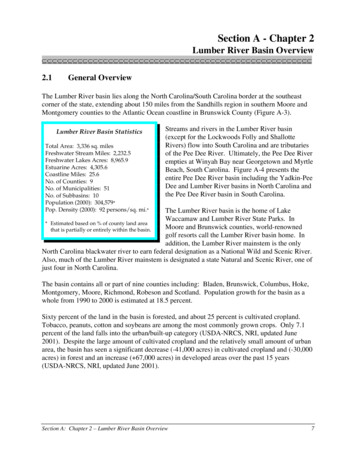
Transcription
IRSC – Criminal Justice Institute – Physical Fitness Preparation GuideIndian River State College/Criminal Justice Institute’sLaw Enforcement and Corrections AcademyPhysical Fitness Preparation GuideINTRODUCTIONThe criminal justice field is both challenging and fulfilling, and will require an individual to exercise a myriadof skills. To be a well-balanced officer, this occupation requires you to be physically and mentally fit.A physical fitness/wellness training program can help you enjoy your career, help you defend yourself, andenable you to benefit from good health after you retire. You owe it to your coworkers, family, and mostimportantly, yourself, to achieve and maintain peak physical fitness for a well-balanced career.This guide is a resource for those individuals preparing to attend the IRSC/CJI’s basic recruit trainingprograms. Individuals should consult with a medical or health professional before beginning any newexercise, nutrition, or supplementation program, or if any personal health questions arise afterreviewing the contents of this guide.The CJI instructors provide recruits with a basic foundation for fitness that includes stretching, exercisetechniques and suggestions for improving cardiovascular endurance. Recruits participate in a moderatelystrenuous physical conditioning program to prepare for both the FDLE Physical Fitness Assessment and topass the physical agility profile tests.What is physical fitness?Physical fitness is the ability to perform physical activities, such as job tasks, with enough reserve foremergency situations and to enjoy normal activities when off duty.Major areas of fitness Flexibility– the ability to move joints and use muscles through their full range of motion. Cardio Endurance– the ability to deliver oxygen and nutrients to tissues and to remove wastes,over sustained periods of time. It consists of both aerobic and anaerobic energy systems. Muscular Strength– the ability of a muscle to exert force for a brief period of time. Upper-body strength, for example, can be measured by various weight-lifting exercises. Muscular Endurance– the ability of a muscle, or a group of muscles, to sustain repeatedcontractions or to continue applying force against a fixed object. Push-ups are often used to testendurance of arm and shoulder muscles. Body composition is also considered an area of physical fitness. Excess body fat increases theworkload placed upon the body and decreases the body's ability to dissipate heat.1
IRSC – Criminal Justice Institute – Physical Fitness Preparation GuideHydrationWater is the major component of blood plasma and makes up 60% of the human body. Water transportseverything in the body and helps regulate body temperature. Every cell depends on water as the universalmedium for carrying out all functions.Water is lost through urine and sweat and must be replaced with 8-10 glasses of water a day. Generally,the more active an individual, or the larger the individual, then more water should be consumed. You canlose as much as 2 quarts of fluid though perspiration during 1 hour of hard exercise in the heat. The bodyrequires water to function correctly while exercising. To calculate water intake needs, divide body weight bytwo. The answer relates to the approximate number of ounces of water to drink per day.If you aren’t replenishing fluids lost (through perspiration) with water or a sports drink, your muscles will tiremore quickly and you may experience muscle cramps. Your body may also have a hard time keeping itscore temperature regulated; this can lead to serious health conditions, such as heat exhaustion or heatstroke.Here are some other tips to protect against dehydration while exercising. Thirst is a sign that you are already dehydrated. Don’t wait until you are thirsty to drink water! Weigh yourself before and after a workout to estimate sweat loss and fluid intake needs. If weightis gained during an exercise session then you are drinking too much. If weight is lost, not enoughdrinking may be occurring. Avoid caffeinated beverages, such as coffee and soda, while exercising; they can promotedehydration. Keep a bottle of water in your gym bag so you have easy access to fluids. Check the color of your urine. If properly hydrated, urine should be clear and lightcolored. If dehydrated, urine may appear cloudy and dark.Warm-up & FlexibilityA warm-up serves several functions, including: increased blood flow to working muscles and joints decreased likelihood of injury decrease in pre-event tension possible improved performance improved flexibilityA proper warm-up of muscles before any physical activity may decrease risk of injury. Spend at least 5-10minutes stretching and warming up and loosening the muscles. The increased blood flow of such a warmup will decrease tension in muscles, improve their range of motion and may even improve performance.Warming-up may significantly reduce the chances of muscle pulls, strains, sprains and other such injuries.When stretching, follow these basic rules: Stretch slowly No bouncing No pain; stretching should feel good Stretching is not competitive Breathe slowly to help relaxYou should always warm-up and cool down properly when exercising.2
IRSC – Criminal Justice Institute – Physical Fitness Preparation GuideCardiovascular Training ProgramAerobic FitnessDuring aerobic activities, the intensity of the exercise is low enough for the cardiopulmonary system to meetthe oxygen demands of the working muscles. Aerobic activities include bicycling, hiking, swimming, climbingstairs, and running when performed at a low enough intensity.Anaerobic FitnessDuring anaerobic activities, the intensity of exercise is so high that the working muscles demand for oxygenexceeds the cardiopulmonary system's ability to deliver. Since adequate oxygen is not available, wasteproducts, such as lactic acid, accumulate. This type of intense activity can only be short in duration. Anexample of an anaerobic activity is sprinting.Speed TrainingSpeed training involves a repeated series of exercise activities interspersed with rest or relief periods. Speedtraining is an excellent exercise for improving both aerobic and anaerobic endurance. Running intervals areperformed on a track or a marked course with intensity at a rate much higher than the aerobic phase.Muscular Strength/Endurance ProgramMuscular Strength/Endurance is a resistance program designed to improve total body strength andendurance. This is not a bodybuilding or a power-lifting program but designed to prepare a recruit specificallyfor the FDLE physical fitness assessments, the physical agility profile tests and the physical conditioning atthe CJI.Circuit training is a very effective and efficient method to improve muscular strength, muscular enduranceand cardiovascular endurance. The workout consists of weight lifting at a station for 10-12 repetitions andthen moving on to the next exercise station. Rest between exercises should not exceed 30 seconds.NutritionProper nutrition begins with providing the body all the essential nutrients including carbohydrates, protein, fats,vitamins, minerals and water. Learning to eat nutritiously is not hard. The key is to: Eat a variety of foods, including vegetables, fruits and whole-grain products; Eat lean meats, poultry, and fish, beans and low-fat dairy products; Drink sufficient water; and Moderate your intake of salt, sugar, alcohol, and saturated fat and trans-fat. Saturated fats areusually fats that come from animals. Look for trans-fat on the labels of processed foods,margarines and shortenings.CarbohydratesCarbohydrates, or “carbs,” the primary fuel for energy, come as complex (starches) or simple (sugars).Some carbohydrates (mostly complex) may contain fiber that helps keeps the intestinal tract healthy. I t i sr e c o m m e n d e d t h a t c arbohydrates make up a s i g n i f i c a n t a m o u n t , s o m e e s t i m a t e 60%, ofthe total caloric intake, with the majority coming from complex sources.Carbohydrates are found in fruits and vegetables and grains, and in refined form in everything from candybars to cakes.Complex carbohydrates are long strings of simple carbohydrates. Because these take longer to process inour bodies, they provide a less readily available, but more sustained, form of energy. Examples includestarchy foods such as potatoes and pasta, as well as many of the commercially available sports gels anddrinks.3
IRSC – Criminal Justice Institute – Physical Fitness Preparation GuideProteinProteins are complex chains of molecules called amino acids that are essential for tissue growth andmuscle development. They have a secondary purpose as fuel in the absence of carbohydrates and fats.Protein should be approximately 15% of the daily caloric intake. Age, body weight, and athletic activitymight also affect the required amount.Protein is the building block for muscles; while simply eating large amounts of protein will not result inmuscle formation, exercising without adequate intake of protein will cause muscle wasting.Protein is most commonly ingested in the forms of meat, poultry or fish. Vegetarians obtain their proteinfrom tofu and other soy products. Commercially available protein formulations are principally composed ofwhey, a milk derived protein. Whey is also found in many protein meal supplement bars.FatsThe primary purpose of fats is to serve as body fuel. Fats also help absorb certain vitamins, build cells,provide insulation and cushion vital organs. The daily caloric intake should contain 20-30% fat.There are three types of fat: saturated, monounsaturated and polyunsaturated. Studies have shown thatmonounsaturated fats increase the levels of high-density lipoprotein (a.k.a. good cholesterol) and lowerlevels of low-density lipoprotein (a.k.a. bad cholesterol). Saturated fats lower the good cholesterol whileincreasing the bad cholesterol. It is recommended that one limit saturated fats for a more healthful diet.Vitamins and MineralsVitamins are organic substances that act as regulators for various physiological processes of the body.Minerals are inorganic elements with similar responsibilities. Vitamins are chemical compounds that serveas important co-enzymes in many chemical processes in the body. All are needed in small quantities on adaily basis. Here is a partial list of commonly discussed vitamins along with their principal functions andwhere they may be found. Vitamin A: Necessary for color and night vision. Found in orange and yellow vegetables.Vitamin B complex: A series of vitamins, the most important of which are B1, B6 and B12. B1&B6 are required for neurological function. B12 has an important role in blood cell formation. B vitaminsare found in grains and meats. Most breads and cereals are fortified with B1 and B6. B12 is obtainedprincipally from meats.Vitamin C: A free radical scavenger, vitamin C has important functions for connective tissue,disease maturation and has a role in immune function. It is found principally in citrus fruits.Vitamin D: Required for proper bone development. Synthesized in the body w hen the skin isexposed to sunlight, it is also found in milk.Vitamin E: Another free radical scavenger, this vitamin has an important role in protectingagainst the formation of mutated DNA. Vitamin E is found in nuts, vegetables, fish and other meats.Vitamin K: Vitamin K is important for the formation of important proteins that controlbleeding. It too is found principally in nuts and vegetables.Weight ControlThere are many conflicting theories, principles, books, articles, etc. on how to lose weight. Be cautious of the“too good to be true” fad diets or supplements. More harm than good usually is the end result. A prudent dietcontains all the essential nutrients and food when eaten in moderation. Achieving a healthy weight can helpcontrol cholesterol, blood pressure and blood sugar. It might also help prevent weight-related diseases,such as heart disease, diabetes, arthritis and some cancers.Eating too much or not being physically active enough may make you overweight. To maintain your weight,the calories you eat must equal the energy you burn. To lose weight, you must use more calories than youeat. A weight-control strategy might include:4
IRSC – Criminal Justice Institute – Physical Fitness Preparation Guide Choosing low-fat, low-calorie foods;Eating smaller portions;Drinking water instead of sugary drinks; andBeing physically activeMaking the right choices about w hat to eat are as important as they are complicated. Fad dietscome and go but the best way to maintain good health is to be smart about what you eat. Doing thismeans having a better understanding of the “what” and “why” of food but also in taking the time to readlabels on everything you buy to ensure the foods you eat are what you want. The single best rule, withrespect to diet, is that moderation is key. Too much or too little of anything is generally a bad thing. Pleaseconsult a physician before starting any kind of diet.What to EXPECT within the first two weeks of an academy programFDLE Physical Fitness Assessment Test ProcessWithin the first 2 weeks of training and then continuing throughout the academy, recruits will participate in anumber of physical fitness training and tests. Recruits who have a solid foundation in physical fitness, orthose who have been actively participating in a physical fitness program just prior to entering into basictraining, generally score higher than recruits who have not been active.Various job task analysis profiles and studies conducted by the Cooper Institute for Aerobics Research(CIAR) have determined the areas and levels of physical fitness which are necessary for performing theessential functions of a criminal justice officer’s job. Data also supports that physical fitness components arethe underlying and predictive factors for performing tasks such as: sustained pursuit/ aerobic power sprints/ anaerobic power dodging/ aerobic/anaerobic power and flexibility lifting and carrying/ muscular strength and endurance; anaerobic power dragging, pulling, and pushing/ muscular strength and endurance; anaerobic power jumping and vaulting/ anaerobic power, leg power and strength crawling/ muscular endurance, flexibility, body fat composition use of force/ muscular strength and endurance, anaerobic power use of force/ muscular strength and endurance, aerobic powerFlorida Criminal Justice Standards and Training Commission (CJSTC) rules require 5 physical fitnesscomponents to be measured at the beginning and end of the Basic Recruit Training Program.1. Vertical Jump. This component measures leg power and consists of measuring how high aperson can jump.2. One Minute Sit-Ups. These exercises measure abdominal or trunk muscular endurance.While students lie on their backs, they will be given one minute to do as many bent leg situps as possible.3. 300 Meter Run. This exercise measures anaerobic power, or the ability to make an intenseburst of effort for a short time period. This component requires students to sprint 300 meters.4. Maximum Push-Ups. This component measures the muscular endurance of the upper bodyand consists of doing as many push-ups as possible until muscular fatigue develops.5. 1.5 Mile Run. This exercise measures aerobic power or cardiovascular endurance stamina overtime. To complete this component, the student must run or jog, as fast as possible, for a distance of 1.5miles.5
IRSC – Criminal Justice Institute – Physical Fitness Preparation GuideVertical JumpPurposeThis exercise is a measure of jumping or explosive power.Procedure1. Stand with your feet together and one side toward the wall, and reach up as high as possible to markyour standard reach.2. Jump as high as possible and mark the highest point of your jump. Jump from both feet in astationary stance. You can pump and thrust your arms upward.3. Your score is the total inches, to the nearest 1/2 inch, above the standard reach mark.4. Record the best score after three trials.6
IRSC – Criminal Justice Institute – Physical Fitness Preparation GuideHow to Prepare for the Vertical JumpA good way to prepare for this component is to do plyometric training. The basic plyometric exercise routineconsists of three exercises: double leg vertical jump, single leg vertical jump, and the double leg hop.Perform each exercise with 1 set of 10 repetitions, 3 days a week. Do the repetitions without stopping, andrest three minutes between each set of an exercise.Double Leg Vertical JumpIntensity Level: HighStarting Position: Stand w ith your feet shoulder -width apart.Direction of Jump: VerticalArm Action: Double arm actionStarting Action: Perform a rapid counter movement and jump as high as possible.Ascent: Thrust arms upw ard vigorously and reach as high as possible.Descent: When your feet hit the ground, jump again immediately w ithout a stutter step.Double Leg Hop IntensityLevel: MediumStarting Position: Stand w ith your feet shoulder -width apart.Direction of Jump: Horizontal, with a vertical component ArmAction: Double arm actionStarting Action: Jump from both legs and strive for maximum distance.Ascent: Think about “ hanging” in the air.Descent: Land in the starting position and immediately repeat the movement .Single Leg Vertical JumpIntensity Level: HighStarting Position: Stand w ith one foot on the ground.Direction of Jump: VerticalArm Action: Double arm actionStarting Action: Perform a rapid counter movement and jump as high as possible.Ascent: Thrust your arms upward vigorously, reaching as high as possible. Descent:When your foot hits the ground, immediately jump w ithout a stutter step.(Place emphasis on maximum height and quick, explosive takeoffs. Repeat this exercise with theopposite leg after a brief rest of 15–30 seconds.)One Minute Sit-UpsPurposeThis component of the assessment measures abdominal muscular endurance.Procedure1. Start by lying on your back, knees bent, heels flat on the floor, and arms across your chest, interlockingyour thumbs into your shirt. Your buttocks must remain on the floor, and do not thrust your hips.2. A partner holds your feet down firmly.3. Then perform as many correct sit-ups as possible in one minute.4. In the up position, you should touch your elbows to your knees and then descend until yourshoulder blades touch the floor.7
IRSC – Criminal Justice Institute – Physical Fitness Preparation Guide5. Your score equals the total number of correct sit-ups. Any resting must be done in the upposition.6. Breathing should be as normal as possible; make sure that you do not hold your breath.8
IRSC – Criminal Justice Institute – Physical Fitness Preparation GuideHow to Prepare for Sit-ups1. Estimate the number of correct sit-ups that you can do in one minute. Multiply that number by .75(75%). Round that result to the lowest number. This will be the number of repetitions (sit- ups) that youwill do per set.2. Warm up with some light activity of your choice, such as stationary biking, walking or jogging on thetreadmill, light calisthenics, etc.3. Perform the number of sit-ups (correct form) determined in the calculation done in #1, above.4. Rest no longer than 60 seconds, and do another set of repetitions.5. Repeat #3 and #4 until you have done three to five sets of repetitions. Even though the last sets may bedifficult, maintain proper form. If you have to hesitate longer on the floor on the last sets to get in the fullnumber, then do so, but rest no longer than what is necessary to recuperate for another repetition.6. Do this routine every other day. Increase the number of reps per set by one or two each week.Note: If you are unable to do at least 5 repetitions per set, you will need to modify your routines toperform sufficient repetitions to address muscular endurance. You should follow a crunch or curl routine foryour abdominals, and also get assistance in designing leg exercises to address the hip flexors.300 Meter RunPurposeThis exercise measures anaerobic power.Procedure1. Warm up and stretch before testing.2. Run 300 meters at your maximum level ofeffort. Record the amount of time it took tocomplete the required distance.3. Walk for 3–5 minutes immediately followingthe test to cool down. This is an importantsafety practice.How to Prepare for the 300 Meter RunTo prepare for this component, it is a good idea to do interval training. First, time yourself running110 yards with all-out effort. This will be your initial time, or IT. Second, divide your IT by .80 to get yourtraining time.Maximum Standard Push-UpsPurposeThis component measures the muscular endurance of the upper body (anterior deltoid, pectoralis major,and triceps).Procedure1. Place hands shoulder-width apart, with your fingers pointing forward. Some part of your hands must liewithin a vertical line drawn from the outside edge of your shoulders to the floor.2. Start from the up position. Arms should be fully extended, elbows locked, and hands and feet onlytouching the floor. Keep the back straight at all times and lower the chest to approximately three inchesfrom the floor. A small rubber ball or sponge (three inches in dimension) can be placed below you on thefloor to check for distance. Then, return to the up position with elbows fully locked. This counts for onerepetition.3. Resting is permitted only in the up position. Your back must remain straight while resting and ispermitted only in the up position.9
IRSC – Criminal Justice Institute – Physical Fitness Preparation Guide4. When you elect to stop or cannot continue, the instructor will record your total number of correct pushups as the score. There is no time limit for this exercise.10
IRSC – Criminal Justice Institute – Physical Fitness Preparation GuideHow to Prepare for Push-ups:1. Estimate the maximum number of correct push-ups you can do in one minute.2. Multiply that number by .75 (75%). Round the result to the lowest number. This will be the numberof repetitions (push-ups) you will do per set.3. Warm up with some light activity of your choice, such as riding a stationary bike, walking orjogging on the treadmill, light calisthenics, etc.4. Perform the number of push-ups (correct form) determined in the calculation done in #2 above.5. Rest no longer than 60 seconds, and then do another set of repetitions.6. Repeat #4 and #5 until you have done three to five sets of repetitions. Even though the last sets may bedifficult, maintain proper form. If you have to hesitate longer on the floors on the last sets to finish everyrepetition, then do so but rest no longer than what is necessary to recuperate.7. Do this routine every other day. Increase the number of reps per set by one or two each week. If you areunable to do at least five (5) repetitions per set, then you may want to get assistance in designing astrength routine that focuses on both core strength and pressing movements.1.5 Mile RunPurposeThe 1.5 mile run is a measure of aerobic power (cardiovascular endurance). The objective in the1.5 mile run is to cover the distance as fast as possible.Procedure1. Warm up and stretch thoroughly prior torunning.2. Run 1.5 miles as fast as possible.3. Do not physically touch anotherparticipant during the run, unlessrendering first aid.4. Finish times should be recorded.5. Upon completing the run, you should cooldown by walking for about five minutes toprevent venous pooling (i.e., pooling of theblood in the lower extremities whichreduces the return of blood to the heart andmay cause cardiac arrhythmia).How to Prepare for 1.5 Mile RunTo prepare for this test, you need to gradually increase your running endurance. Begin at the level you canaccommodate, and use a workout format that involves walking and running. Run a short distance, walk for awhile, and then run again. Begin slowly and then proceed to the next level by improving your overall runningor walking time.References Florida basic recruit Training Program – High Liability – Vol 2 – Version 2014.07 Cooper Institute (2010) Principles of Health and Fitness for Fitness Professionals Manual. Broward College – Institute of Public Safety Basic Motor skills testing Sharkey, Brian J. (1997) Fitness and Health, Fourth Edition. Human KineticsEditor’s note: This document was originally created in 2015 by Tammy Spaulding, the lead physical fitness instructor at Broward College’s Institute of Public Safety,using material from Chapter 6 of the High Liability Basic Recruit Training handbook, Volume 2, Version 2012.07. It was intended for use by its law enforcementacademy applicants and recruits. With permission from Linda Wood, the Dean of that same Institute, to reproduce this document, it has been mildly repurposed andedited for the use by the law enforcement and corrections academy recruit-students at the Criminal Justice Institute at Indian River State College. The editor and staffof the IRSC/CJI wish to acknowledge and express their sincere appreciation to both Tammy Spaulding and Linda Wood for allowing its use.11
IRSC - Criminal Justice Institute - Physical Fitness Preparation Guide 3 Cardiovascular Training Program Aerobic Fitness During aerobic activities, the intensity of the exercise is low enough for the cardiopulmonary system to meet the oxygen demands of the working muscles. Aerobic activities include bicycling, hiking, swimming, climbing











